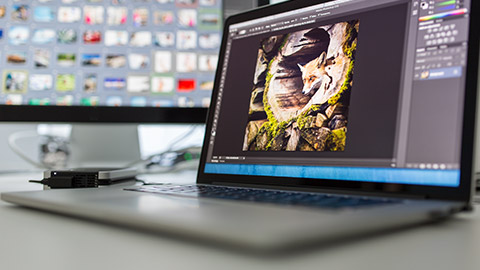In this section of the module, you will learn about the following:
- Gain approval for written and visual content.
- Upload content to digital platforms using approved file extension scheme.
- Arrange content in a logical design for improved user experience.
- Ensure content is displayed in a visually appealing manner.
- Seek input of relevant personnel to ensure accuracy and relevance of written and visual content.
- View the content in closed contention mode, test on multiple devices, and make any required amendments.
- Archive content and ensure version control is applied to track content history.
- Ensure content is securely stored and backed up.
The creative review and approval process is the partnership around creating and completing creative content. This can include all kinds of content, from print ads to websites to product labels and visual content.
The review and approval process means all of the many versions, assessments, sign-offs, comments, feedback, and shareholders involved in getting a piece of content or marketing promotion from ideation to finished content. Ultimately, creative review and approval is the chronological sequence in which content and information flow for creative decision-making and modifications.
There are several best practices to contemplate when sharing work and making the proper workflows to handle and approve the written and visual content review process.
Below are the areas you must cover when formatting your creative review and approval process:
- Identify the main steps and stages of your review process.
- Determine precisely who should review content and when
- Define your internal review phases and quickly connect external critics to those processes
- Make a content versioning system that works for your team’s collaboration needs.
- Enforce the proper deadlines and automated reminders to streamline the review
- Flow content from work-in-progress to prepare-to-review with minimum effort
- Automate complicated, non-linear, multi-stage review procedures that involve many departments and decision-makers.
Reflection
Have a think about what you have just read and reflect on the following questions.
- What is the importance of the creative review and approval process in approving written and visual content?
- Why is it vital to gain the approval of certain personnel for your written and visual content?

Digital file types define the types and characteristics of the files generated from the digitisation of original record materials and the standard or most popular data formats that the Digitization Services Branch uses to store digitized records.
Still image file
A kind of digital object generated from the digitization of still image (textual documents and photos) originals. A still image is an information in which a grid or raster of picture features (pixels) has been mapped to signify a visual subject.
- JPEG: Joint Photographic Experts Group: JPG and JFIF (Joint Photographic Experts Group/JPEG File Interchange Format) is a standard file format for keeping raster photo data. JFIF is the file format and JPG is the solidity method JPG/JFIF is required in the JPEG File Interchange Format and JPEG.
- TIFF: Tagged Image File Format: a popular format for storing raster image data.
- PDF: Portable Document Format: a standard format for keeping many types of information including raster images.
Audio File
An audio recording generated from original analog or digital audio formats that has been encoded using linear Pulse Code Modulation (PCM). For audio files, it is essential to distinguish between a file format and a codec. A codec completes the encoding and decoding of the raw audio data while the information itself is stored in a particular audio file format, such as Broadcast WAV (.wav). o WAV: Waveform o MP3
Video File
A moving picture recording with synched audio produced from any original analog or digital video formats. Pixel array, aspect ratio, frame rate per second, bit rate, color space, field order, and standard or high definition, for example, are important characteristics of video files.
- MOV: Quicktime
- AVI: Audio Video Interleaved
- MXF: Material Exchange Format
- WMV: Windows Media File
- MEPG-2
Motion Picture File
A high-resolution moving image recording, frequently with synched audio, is produced from either original physical or digital formats. Frame rate per second, bit-depth, a pixel array, and color encoding, for instance, are essential characteristics of motion picture files.
- DPX: Digital Moving-Picture Exchange
- DCP: Digital Cinema Package
Reflection
Have a think about what you have just read and reflect on the following questions.
- What are digital files?
- What is a still image file and its file extension scheme?

User interface (UI) design is the method designers use to create interfaces in software or computerised devices, focusing on looks or style. Designers intend to create interfaces which users find comfortable to use and comforable. UI design refers to graphical and visual user interfaces and other content.
Designing user interfaces for users
Graphic users interfaces (GUIs)
Users interact with visual images on digital control panels.
Voice-controlled interfaces (VUIs)
Users connect with these through their voices.
Gesture-based interfaces
Users engage with 3D layout spaces through bodily movements.
How to make a great user interface
- Make buttons and other standard elements perform obviously (including responses such as pinch-to-zoom) so users can instinctively use them everywhere. The form should follow the function.
- Retain high discoverability. Clearly label icons and include well-specified affordances.
- Keep interfaces uncomplicated (with only elements that help serve users’ functions) and create an “invisible” feel.
- Respect the user’s eye and attention regarding design. Focus on hierarchy and readability:
- Use proper alignment. Usually, choose edge (over center) alignment.
- Draw attention to important features using:
- Color, brightness and contrast. Prevent including colors or buttons unreasonably.
- Text via font sizes, bold type, italics, capitals and distance among letters. Users must pick up meanings just by scanning.
- Minimize the amount of actions for performing tasks but aim on one chief function per page. Lead users by indicating desired actions. Ease complex functions by using advanced disclosure.
- Put controls near objects that users want to use. For instance, a button to submit a form must be near the form.
- Keep users informed concerning system responses and actions with feedback.
- Use proper UI design patterns to help guide users and lessen burdens. Beware of using dark designs, which include hard-to-see prefilled opt-in and opt-out checkboxes and slipping items into users’ carts.
- Maintain product consistency.
- Always offer next steps which users can deduce naturally, whatever their context.
Reflection
Have a think about what you have just read and reflect on the following questions.
- What is the user interface design?
- What are the guidelines to make your user interface effective for user?
Human brains are prepared to remember and respond to images – but that doesn’t mean visual thinking comes inherently to everybody. And if you find yourself feel a little bit exhausted by the new requirement that everything looks great, it can be hard to know where to begin.
Here are five (5) simple ways to visually appealing content for any website:
Use a psychology of colour to your advantage
Ideally, the color selections on your site reflect a cohesive branding approach, including base and accent colors. Colors should be reliable but suggestive of the emotions behind your product.
Use shapes- not just squares
With the introduction of flat design, it’s enticing to stick to simple squares as the basis of your whole site design. Sure, this can make a streamlined appearance that reduces distractions and keeps things clean, particularly for mobile users – and that might be precisely what you want.
In a world of universal color blocks, though, curves and eye-catching shapes add some graphic flair. That can help you keep a reader’s interest and motivate them to scroll through your content.
Use contrasting colours
Once you have a simple color palette you want to work with, you’ve got the power to utilise color contrasts for maximum impact. Specific elements, like calls to action, must always be used with contrasting color boxes. Items that “pop-out” like this is much tougher to overlook.
Use people
Over millions of years, the brain has been created to focus on faces and interpret expressions quickly. Our environment always has more data than we can take in, but our brains believe faces to be priority motivation no matter where we are or what we’re doing. Even seeing a photo of a person’s face can generate an emotional connection with that in mind.
Combine text and imagery
On social media, combining text and pictures can make for more substantial content. Include this combination into your social media marketing approach, whether on Facebook, Twitter, or Instagram, will create stability and provide more value to your audience.
Reflection
Have a think about what you have just read and reflect on the following questions.
- Why do you need to make visually appealing web content?
- What is the importance of using various shapes in your content?

To enhance your skills and grow professionally, you must get feedback on your work. Feedback can help you to enhance your performance and improve your career prospects.
Asking for feedback can be a bit frightening because you're opening yourself up to potential criticism. This can be challenging at first.
You can conquer this fear by changing your mindset. Keep in mind that no one is perfect – all of us make errors, and there's always room for development.
How to ask for feedback
Consider the Timing
It is vital to consider the timing when seeking feedback on something particular, such as the recently submitted work. It's most beneficial to ask for it right after you submit the content to your immediate superior. This immediacy will make sure that you get the most accurate picture of your performance.
Be Specific
Tell the person precisely what he needs to improve. This guarantees that you stick to facts and there is less room for vagueness.
Be graceful
If you receive negative feedback, it's enticing to provide an excuse for your performance or blame someone else.
Therefore, it's crucial to learn how to handle criticism with kindness. Remember, you asked for this chance to improve! Be open and diplomatic in your replies, and thank the other person for their time and effort.
Really Listen
When you receive feedback, you may instantly begin thinking of excuses to justify your behavior, or you might start planning what you're going to say when the other person has finished talking.
Reflection
Have a think about what you have just read and reflect on the following questions.
- What is the importance for seeking feedback to your written and visual content?
- What are some ways to seek feedback?

The way we consume content is shifting at a quicker pace than at any time in history. While the change from print to digital was earth-shattering from a structural perspective, things have not ceased moving ever since.
The increase of mobile and now tablet use is changing the landscape and adding a layer of complexity that companies have never had to deal with before.
To generate a genuinely data-informed picture, however, we need data on variables such as:
- What device is used, and when, in the day?
- The order of devices in the classic purchase funnel
- Which devices do we use to access critical content platforms?
- How long we spend on each device and what we look at on them?
When it comes to evaluating and asses the digital content, you want to look for the best digital content available. It is best to assess the content in the following areas:
Assess the User Interface
Even if the digital content is excellent, it will not be a helpful tool to your customers if it is challenging to use. Thus, you must test out the user interface. Is it simple to navigate? Will your clients be able to browse materials and find their way across the content with ease? You must also look for digital content that is optimised for various devices.
Assess the Individualization Possibilities
technology has improved, it is easier to allow for individualisation. Customers should be able to use the digital content individually and then have chances to reinforce abilities. Additionally, the content must provide a variety of options and the ability to track the traffic on the site.
Assess the interactive Elements
Digital content must be innovative and encourage clients to connect. Therefore, you must pay attention to the graphics and interactive elements. Though, you should likewise pay close attention to the amount of interaction at hand.
Reflection
Have a think about what you have just read and reflect on the following questions.
- What is the importance of assessing and testing digital content?
- Why do you need to assess the interactive elements in your website?
Digital archiving is a storehouse of digital material that a business desires to keep for a more extended period. It stores compilations of digital information like documents, video, pictures, etc., in a digital format to provide long-term access to the data. A digital archive can be an elaborate compilation with a multi-tiered storage system or located on a hard drive.
Considerations for digital archiving
Digital archiving looks like it would be a one-and-done responsibility. However, several things to consider when storying memories and items you have decided must be kept for archival purposes.
- Obsolescence: With innovations in technology, storage media comes and goes. Updating your digital archive is an essential part of your digital archive policy.
- Metadata: This is a significant component when digital archiving. Without it, or a sufficient amount of it, you will have trouble finding the information you want when trying to retrieve it.
- Defining what is suitable for a digital archive.
- Corruption of info.
- Loss of data (the hard drive, SD card, etc.).
- Accuracy and reliability of data.
- In-house or outsource?
- Safety and access
Benefits of digital archiving
- Businesses have long kept archives for a range of reasons: remember one project or promotion to the next; keep in mind what went wrong and right; significant company milestones; and essential contributions to the society in which the company is located.
- Another benefit to digitising your archives is that it makes locating data easier. You don’t have to spend extended time going through old file boxes to find the correct one immediately. Multiple people can gain access to the same information at the same time. If you have a big company or numerous locations, it makes data storage or libraries simpler to access for employees.
- Avoiding loss of data is more accessible with digital archives because they can be have backed up. Loss of records is a risk for both conventional (paper, etc.) and digital. With digital, creating backups that can also be kept in different locations is more cost-effective than making paper copies and storing them separately.
Reflection
Have a think about what you have just read and reflect on the following questions.
- What is digital archiving?
- What is the importance of digital archiving?
Data backups are essential for good storage security and total business resilience, but they're frequently the source of many security troubles. A substantial percentage of security breaches can be credited to the mismanagement of data backups. The headlines and safety surveys underscore the reality that sufficient data backup controls are missing. As much as individuals dislike the term best practices, they're indeed needed when it comes to fleshing out a business data backup plan.
Include back-up in your security strategy
Make sure your security policies contain backup-related systems within their scope. Almost every type of security policy -- from entry control to physical security to system supervising and, especially, malware protection -- pertains directly to data backups.
Include backup systems in your DR strategy
Data backups can be penetrated, compromised, or destroyed in the circumstances such as a ransomware outbreak, personnel break-in, or something environmental, including a flood or hurricane. If not, good backups can be adversely impacted, and you must have a plan defining what you are going to do if and when that moment comes.
Limit access rights to data backups
Assign backup access privileges only to those who have a business need to be concerned in the backup process. This goes for backup software along with the actual backup files. Don't ignore systems both on the local network and in the cloud that gives backup access.
Ensure backup media devices are protected
Although the common practice these days is to store backups on hard disk or solid-state drives, some backups are still kept on portable drives, tapes and related media. When this is the circumstance, use a fireproof and media-rated safe. Many individuals store their backups in a "fireproof" safe, but frequently one that's only rated for paper storage.
Ensure your network is secure
Store backups on a different file system or cloud storage service that's located on a physically or logically separated network. Single login credentials outside of the enterprise directory service are perfect to help reduce ransomware-related risks. Multifactor validation can add an additional layer of security in your backup environment.
Make a comprehensive backup and test regularly
Make sure you're backing up everything that's essential. Several backups are server- or application-centric, though what about all that unstructured information scattered about your network and in the cloud that is not getting backed up? Second, test your backups sometimes, especially if you're not getting any errors on your backups.
Reflection
Have a think about what you have just read and reflect on the following questions.
- Why do you have to limit access rights to data back ups?
- How can you make sure that your data back ups are protected?
